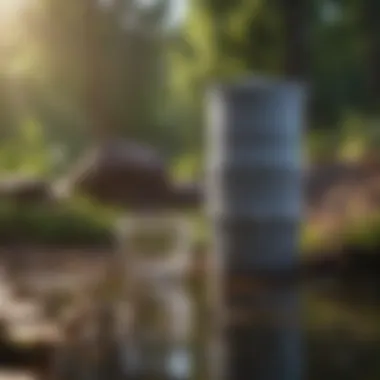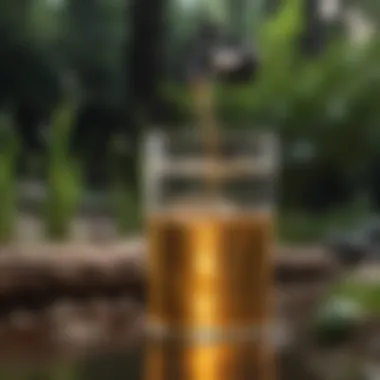A Guided Exploration: Building a Water Filter with Kids for Clean Water


Nature Topic Overview
Water is a fundamental resource vital for sustaining life on Earth. In many parts of the world, access to clean water is limited, highlighting the importance of water filtration. This guide aims to educate children aged 5-12 on building a water filter using simple materials, fostering an understanding of the significance of clean water sources and sustainable practices.
Fun Facts and Trivia
Did you know that only about 1% of the Earth's water is suitable for drinking? By learning how to build a water filter, kids can appreciate the value of clean water and the impact of pollution on our water sources. Engaging visuals and interactive elements will enhance the learning experience for young readers, making it both fun and educational.
Wildlife Explorations
Exploring the topic of water filtration can also involve understanding how various species rely on clean water for survival. Children can learn interesting facts about aquatic animals and plants that thrive in unpolluted environments. Quizzes and puzzles related to water conservation can further pique their curiosity and deepen their connection to nature.
Environmental Awareness
Water filtration aligns with the broader concept of environmental conservation and sustainability. Kids will grasp the importance of protecting natural resources and learn simple tips on how they can contribute to preserving clean water sources. Fostering environmental awareness from a young age empowers children to become stewards of the planet.
DIY Nature Activities
Encouraging hands-on learning, this guide will include step-by-step instructions for kids to construct their water filter at home. Through nature-inspired crafts and projects, children can explore the practical applications of water filtration concepts. Additionally, suggestions for outdoor explorations will allow them to observe firsthand the impact of clean water on the environment.
Introduction


In the realm of knowledge about the invariably bountiful universe, the initiation holds a paramount significance that resonates with perpetual splendor. Imagine young minds, bright and curious, embarking on an odyssey of discovery towards a pragmatic yet captivating quest - the creation of a water filter. This article stands as a beacon, illuminating the path for our future custodians of the Earth, aged 5 to 12, towards comprehending the essence of clean water and sustainability.
As we delve into the bucolic world of O filtration, an understanding rooted in awareness blossoms forth. Behold, a gateway to enlightenment! Picture a canvas awaiting the strokes of youthful mastery, where each detail contributes to a larger tapestry of knowledge. The exposition of water filtration for our budding pioneers takes center stage, revealing a trove of insights, facts, and practical wisdom.
Let us decipher the arcane meanings of purifying water, an age-old practice steeped in the wisdom of our forebears and resurfacing here in a modern guise. Herein lies the heart of our narrative: the fusion of tradition and innovation, packaged in a format accessible and intriguing to young inquiring minds. Through inquisitive exploration, children will grasp the profound import underlying the clarity of water, not merely as a physical force but as a symbol of purity and sustainability.
Within these virtual pages, a veritable treasure trove of revelation awaits, promising to awaken a sense of responsibility and environmental consciousness in our youthful readers. This isn’t just a mere guide; it's a doorway to understanding, to a communion with nature essential in fostering a generation attuned to the needs of a fragile planet. Let the voyage begin, brimming with excitement and knowledge, as we carry the torch forward towards a brighter, cleaner tomorrow.
Understanding Water Filtration
When delving into the depths of water filtration, several key elements come into play. Firstly, the filtration medium plays a vital role in trapping impurities. Whether it's gravel, sand, activated charcoal, or specialized filter paper, the medium's composition directly impacts the filtration efficiency. Understanding the properties of each medium and how they interact with contaminants is essential for building an effective water filter. Additionally, the flow rate of water through the filter is a critical consideration. Balancing flow rate with filtration efficiency is a delicate yet crucial aspect of the water filtration process.
The benefits of understanding water filtration extend beyond the confines of this guide. By grasping the intricacies of filtration, children not only learn a valuable skill but also develop a keen awareness of environmental sustainability. The ability to purify water using simple materials empowers kids to make a positive impact on their surroundings and encourages them to think critically about resource conservation. Furthermore, understanding water filtration cultivates a sense of responsibility towards maintaining clean water sources and protecting the environment for future generations.
What is Water Filtration?
What precisely is water filtration, and why is it a fundamental concept in the context of this guide? Water filtration is the process of eliminating impurities from water, such as particles, bacteria, chemicals, and odors, to make it safe for various applications, including drinking, bathing, and irrigation. This filtration method involves passing water through a porous medium that captures contaminants while allowing clean water to pass through.
When discussing water filtration with children, it's essential to emphasize the tangible outcomes of this process. By employing materials like sand, gravel, and cotton balls, young learners can visually witness the separation of impurities from water. This hands-on experience not only educates them about the principles of filtration but also sparks their curiosity and creativity.
In essence, water filtration is the gateway to clean, safe water, teaching children valuable lessons about sustainability, resource management, and the importance of environmental stewardship. By understanding the mechanics of filtration and its practical applications, kids can cultivate a deeper appreciation for the precious resource that is clean water.


Importance of Clean Water
Clean water is not just a luxury but a fundamental requirement for all living beings on Earth. In this insightful article about building a water filter, we delve into the critical significance of clean water in sustaining life. Water, being a primary component of all organisms, plays a pivotal role in various bodily functions and processes. Adequate hydration is essential for maintaining proper health and bodily functions, especially for growing children. Ensuring access to clean water is crucial for preventing waterborne diseases and promoting overall well-being. By emphasizing the importance of clean water, children can develop a deeper appreciation for this precious resource and understand the necessity of preserving it for future generations.
Why Clean Water is Essential
Clean water is an essential resource that is indispensable for various daily activities and essential functions of the human body. Water is the basis of life, making up a significant portion of our physical composition. Access to clean water is crucial for maintaining good health, supporting proper hydration, and enabling the body to function optimally. Children, in particular, require clean water to support their growth, development, and overall health. Lack of access to clean water can have severe consequences, leading to a host of health issues, including dehydration, waterborne illnesses, and even fatalities in extreme cases. By understanding why clean water is essential, young readers can grasp the vital role that water plays in their lives and the importance of conserving this valuable resource.
Materials Needed
In the process of building a water filter, the materials play a crucial role in ensuring its effectiveness. Understanding the significance of the materials needed is essential as it directly impacts the quality of the filtration process. By assembling the right supplies, children can witness firsthand the transformation of dirty water into a cleaner state, grasping the importance of clean water sources. Moreover, the materials needed for this project are easily accessible, making it a feasible and educational DIY activity for kids. By engaging in gathering the necessary supplies, children not only learn about water filtration but also develop hands-on skills and environmental awareness.
Gathering the Supplies
Gathering the supplies is a fundamental step in the process of building a water filter. Children are encouraged to collect items such as sand, gravel, cotton balls, and activated charcoal, emphasizing the diverse layers needed for effective filtration. By sourcing these materials, kids learn about the varying functions of each layer and how they contribute to the overall filtration process. Additionally, parents, teachers, or caregivers can participate in this activity by guiding children in selecting the materials and highlighting the importance of each component. Through hands-on experience in gathering the supplies, children gain a practical understanding of water filtration principles and the significance of using the right materials.
Step-by-Step Guide
The step-by-step guide section in our article details the crucial process of creating a functional water filter. This segment serves as the heart of our guide, providing children with a hands-on approach to learning about water filtration and its significance. By following each step meticulously, young readers will not only grasp the practical aspect of filter construction but also develop essential problem-solving and critical thinking skills. The step-by-step guide acts as a bridge between theory and application, reinforcing the concepts discussed in the previous sections. It is designed to ensure a seamless learning experience that is both educational and engaging.
Creating the Filter Container


In this stage of building a water filter, the creation of the filter container takes center stage. This process involves the selection of an appropriate vessel to house the filtration materials securely. Children will learn about the significance of choosing a suitable container size and material to maintain the filter's integrity throughout its usage. The step-by-step instructions will cover aspects such as proper sealing techniques, ensuring that the container is leak-proof to avoid water wastage. By emphasizing the importance of the filter container, young learners will understand the foundational role it plays in the overall functionality and efficiency of the water filtration system.
Assembling the Filtration Layers
Assembling the filtration layers is a critical stage in the water filter construction process. This section focuses on arranging different materials in a specific order to create effective filtration. Children will explore the characteristics and functions of various filtration layers, such as gravel, sand, and activated charcoal, learning how each component contributes to purifying the water. Detailed instructions will guide young readers on the proper layering technique, ensuring optimal filtration performance. By delving into the intricacies of filtration layers, children will develop a deeper understanding of how different materials work together to produce clean and safe drinking water.
Testing the Water Filter
The testing phase of the water filter project is an essential step to assess its functionality and efficiency. This section guides children on conducting quality assessments to ensure that the filter successfully removes impurities from the water. Through hands-on experiments and observation, young readers will learn how to analyze the filtered water for cleanliness and taste. Additionally, they will explore troubleshooting methods to rectify any issues that may arise during the testing process. By emphasizing the significance of testing the water filter, children will hone their analytical skills and scientific inquiry, cultivating a sense of accomplishment as they witness the successful results of their filtration efforts.
Understanding Environmental Impact
In the context of this comprehensive water filtration guide for kids, Understanding Environmental Impact emerges as a pivotal aspect worth delving into. At the core of this section lies a profound exploration of the consequences our actions have on the environment, particularly in relation to water sources and filtration systems. By shedding light on how human activities can impact the quality and availability of clean water, children are sensitized to the urgent need for environmentally responsible behavior. This section aims to elucidate the interconnectedness between human actions and the environment's well-being, emphasizing the crucial role young individuals play in preserving natural resources. By instilling a sense of environmental stewardship from a young age, this guide nurtures a generation of conscious citizens who prioritize sustainable practices, thus fostering a healthier planet for future generations to inherit. To further enhance this understanding, illustrative examples of real-life environmental impact scenarios are provided, showcasing the adverse effects of pollution and negligence on water bodies and aquatic life. Children are encouraged to reflect on these cases, engendering a sense of empathy and responsibility towards safeguarding the environment's delicate balance. By instilling empathy and knowledge, kids are empowered to make informed choices that positively influence their surroundings, thereby contributing to a cleaner, greener world.
Conserving Clean Water Sources
Amid the extensive discourse on water filtration, the subsection of Conserving Clean Water Sources stands out as a paramount discussion point. Delving into this topic delves to highlight the intricacies of sustaining the purity and abundance of water reservoirs and springs, underscoring the indispensable role of conservation efforts in ensuring water security for current and future generations. This segment imparts valuable insights regarding the significance of preserving clean water sources, elucidating the dire consequences that stem from resource mismanagement and contamination. By nurturing an appreciation for the finite nature of freshwater resources, children are encouraged to adopt mindful practices that minimize water wastage and pollution, thereby safeguarding the planet's irreplaceable water reservoirs. The importance of implementing eco-friendly strategies, such as rainwater harvesting and responsible water usage, is underscored throughout this section, illuminating sustainable pathways towards water conservation. Through practical tips and engaging activities, young readers are empowered to actively participate in safeguarding clean water sources, instilling a sense of accountability and environmental stewardship within them. Furthermore, the socioeconomic implications of water scarcity and unequal access to clean water are expounded upon, fostering a holistic understanding of the multifaceted issues surrounding water conservation. By equipping children with knowledge and actionable strategies, this guide empowers them to become proactive allies in the global quest for clean and sustainable water sources.
Conclusion
In the realm of water filtration for kids, the conclusion serves as a pivotal point where the significance of practical learning and understanding environmental impact converges. This conclusion encapsulates the core essence of the article, emphasizing the pivotal role children play in fostering a sustainable future. Through the process of building a water filter, youngsters grasp the fundamental concepts of clean water importance and conservation efforts, nurturing a sense of responsibility towards the environment.
This article unfolds a pathway for children aged 5-12 to not only construct a water filter but also unravel the intricate connection between clean water sources and their daily lives. By delving into the step-by-step instructions and material requirements, kids embark on a journey of hands-on exploration, igniting their curiosity and environmental consciousness. The conclusion acts as a compass, guiding young minds towards a deeper comprehension of the world's water resources and the imperative need to preserve them for future generations.
Furthermore, the robust educational framework woven into this guide transcends mere technicalities, instilling in children the values of resourcefulness, innovation, and sustainability. Through the tactile experience of creating a functional water filter, kids not only hone their practical skills but also develop an innate understanding of the interconnectedness between human actions and environmental outcomes. The conclusion reinforces this interconnectedness, accentuating the profound impact young individuals can have on mitigating water pollution and safeguarding precious water sources.
In essence, the conclusion of this article propels children towards a trajectory of environmental stewardship and conscientious engagement with the world around them. By sowing the seeds of environmental awareness and activism early on, youngsters are empowered to become catalysts for change, heralding a future where clean water is a non-negotiable right rather than a scarcity. The conclusion resonates with a call to action, urging young readers to not just build a water filter but to embark on a lifelong journey of sustainable practices and advocacy for the preservation of our planet's most vital resource.







